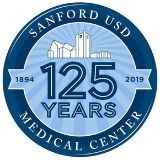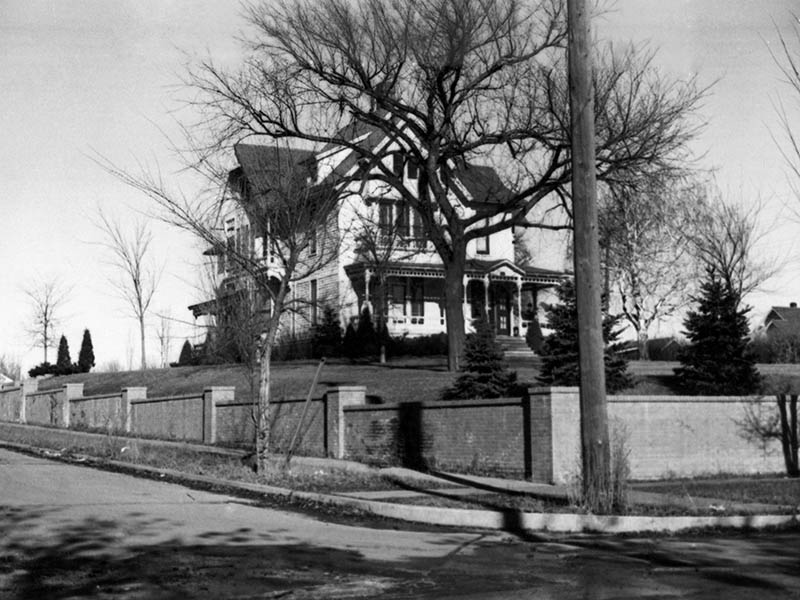
Step back in history, and imagine you’re living in a city of 10,000. People rely mostly on horses for transportation. Vaccines for a host of potentially deadly contagious infections don’t exist. Surgeries and childbirths, even high-risk ones, occur at the patient’s home with a visiting doctor.
Because this city lacks a hospital. It lacks a place with medical equipment for doctors to treat emergencies, a place for patients to recover with the care of trained nurses, a place for epidemic patients to be isolated.
Thankfully, Sioux Falls has changed a little since 1894. About 18 times more people now call the city home. And in that summer 125 years ago, the seed of what later grew into Sanford Health was planted in a large rented house near present-day Terrace Park.
A group of determined Lutheran clergy and laymen organized the only hospital in the city. Sioux Falls Hospital’s doors opened that summer to all practicing medical doctors and all patients in need of care.
The location and name may have shifted a few times since, and medical needs may have changed, but several traditions that began then still abide: Be what the community needs. Give patients the best treatment possible by the most skilled medical staff possible. And give back to the community and to each other.
From maintenance to management
The 125-year history of the hospital in Sioux Falls that grew into today’s Sanford Health is stocked with notable names and their stories of significance. But it’s hard to imagine any of them seeing quite as much variety as Lyle Schroeder, who served as the head of then-Sioux Valley Hospital from 1961 to 1997.
Schroeder led for more than a quarter of the hospital’s history, overseeing substantial building projects and medical advances. But before that, he had come to know the hospital pretty intimately as he worked nights in maintenance and laundry while attending Augustana University.
So in the early to mid-1950s, he unclogged toilets and changed light bulbs and hauled around oxygen tanks and collected garbage for some of the very people he would eventually lead.
Retired for more than 20 years now, Schroeder still conveys a sense of passion and vision, along with humility, during a conversation reflecting on his time with Sioux Valley Hospital. He’s retired but not out of touch with the hospital. The recent conversation also included Paul Hanson, president of Sanford Sioux Falls, who clearly has admired Schroeder since they met in 2000.
Hanson’s unabashed enthusiasm to participate in this conversation, even welcoming it into his office, is perhaps a signal of one of Schroeder’s secrets of success: connecting with people.
‘Everybody was so friendly’
Schroeder saw examples of connection when he first worked at Sioux Valley Hospital. “I did not have a position of any consequence when you think about maintenance, laundry,” he said.
“But the thing that impressed me was that everybody was so friendly. And it didn’t really make any difference who (you were) or what you were doing, you were accepted as one of the employees. I sure did appreciate that.”
He didn’t forget it, either, after he earned a bachelor’s degree in business administration and a master’s degree in hospital administration, then came back to serve as assistant administrator for a very short time. He took over the head position after administrator Jack Rogers resigned.
“I had a good relationship knowing what was going on in the lives of those people. I could relate to the job that they had and what work they were doing here, and I appreciated what they were doing for the hospital,” Schroeder said.
Originally a Pipestone, Minnesota, farm boy who attended a one-room schoolhouse, Schroeder was young for his new job. “I had no idea that I would have that role that early in my life,” he said.
“The only thing I thought back then is that I was going to work very hard, and hopefully that my work and my output and my decision-making would be in keeping with what the hospital wanted and desired.”
‘That took courage’
Kelby Krabbenhoft, who succeeded Schroeder in 1997 and eventually became president and CEO of Sanford Health, also served in a much lower-ranking hospital role before reaching leadership. He worked as an orderly during graduate school, and during his college summers before that.
Then in his first administrative job, in an Iowa town of about 900, Krabbenhoft lived close to the hospital. “I had to know how to start the boiler and shovel the sidewalks because maintenance guys couldn’t get in in a storm,” he said.
“So I know the job and I know the business and the organization, and through that, I know the people.”
Krabbenhoft finds inspiration for his leadership in the very earliest leaders of Sioux Falls Hospital.
“They started a hospital. They had the gumption and the idea that they should do something great, something bold, which really makes what I’m doing and what we’re doing today kind of routine,” Krabbenhoft said.
“We have it pretty easy. I can fly on an airplane or hop in a car and solve my problems. When I think back about that, 125 years ago, that took courage. That took guts to get things done. I try to instill that in my team.”
Jumping right into a building project
Schroeder didn’t exactly get to ease into his new role in 1961. A building project, the three-story “west wing” for the crowded hospital, needed to get under contract by a looming date or risk losing federal funding sources.
No doubt lessons Schroeder learned on that first big project benefited him during the numerous construction phases that followed.
Of course, he wasn’t the first to face building challenges in a continually growing city. Sioux Falls Hospital outgrew its first location within four years. In 1898, it moved downtown, to the Cameron House at 10th Street and Dakota Avenue (now the location of CenturyLink). Then in 1900, a two-story, 20-bed hospital built on the northeast corner of 19th Street and Minnesota Avenue opened with a new name of Sioux Falls Lutheran Hospital.
In 1925, the hospital board merged with Bethany Association, and the hospital became Sioux Valley Hospital. Plans called for a new six-story hospital building on what was then the edge of town, running north-south along Euclid Avenue at 20th Street. The building, which opened in 1930, is still in use in the center of the Sanford USD Medical Center campus. The hospital added the “north wing,” which angles to the northwest of the original building, in 1944.
Schroeder’s 3 crucial questions
“One of the things that surprised us was the rapidity of the growth that we had at the hospital and the growth of Sioux Falls at the time,” Schroeder said. But he had a strategy to approaching ideas for new projects.
“I had three questions that I always asked, when we talked about any growth or any new program. The first question: Is it needed? The second question: Can we do it well? And the third question is: Can we be price-competitive with everybody else? If the answer was yes on all of those, then we would do it.”
In 1973, the first floors of the nursing tower to the east of the main hospital opened, closing off Euclid Avenue. The project was part of an expansion program that Sioux Valley had developed in consultation with McKennan Hospital to help meet medical needs of the entire community. Each hospital would stagger phases of its building plans to add patient beds gradually, rather than too many at one time.
To the community, it may have looked like a building race between the hospitals, Schroeder said, but it was all a strategic plan.
“The growth ended up pretty well managed, I think,” Schroeder said.
‘We just kind of grew up together’
Schroeder estimated Sioux Valley Hospital had about 500 employees when he took over. Hanson compared that to 7,000 today in the Sioux Falls hospital and clinics.
Hanson said people with long memories have made comments to him: “‘I remember Lyle Schroeder walking the halls. He knew every employee’s name.’”
But Schroeder’s familiarity with the employees came naturally, he explained. “You’ve got to remember, I kind of grew up with a lot of the people that were here when I was going to college and running around the halls with a plunger on my back.” A large group of nursing students were his age, too.
“We just kind of grew up together, is what happened, and not too many times do you have that opportunity.”
In addition to walking through the hospital units daily, Schroeder had another mission. “I always had an objective that each day I should visit a patient, because if I didn’t, then I may forget why we were here and who we were here for,” Schroeder said.
That helped shape his leadership advice as well. “I always used to tell the employees that what we ought to do is take care of every person that we have as a patient. If it’s an elderly person, think of them as your mother or your father or your sister. Or if it’s a young person, one of your own children. That if we took care and treated everybody as if they were a part of our family, then we would probably give them pretty good care.”
‘Right people in the right places’
Sanford Health considers patients and employees alike part of its large family — a family with a bright future.
“When you consider yourself a steward, through time, my time in the relative scale of things will be very short in the history of Sanford … and we’re an organization that’s going to be around for another 125 years,” Hanson said.
“What we look like, who we are, how we act — it’s going to change, but we’re going to have the right people in the right places to make the right change.”
It seems the right people have been at the right place in the past as well.
Interestingly, Schroeder abandoned his first college plan, to attend South Dakota State, when he had the chance to play football as a freshman at Augustana.
“If I had gone to South Dakota State, I’d probably be a county Extension agent or ag weed inspector,” Schroeder said. Instead, his college job at a hospital started him dreaming of helping patients, not plants.
Krabbenhoft, too, dreams of what’s ahead for Sanford Health’s patients.
Forecasting for his successors in the next 125 years — even just into the next 50 — Krabbenhoft imagines genetics and stem cell therapies will become routine.
“We’re going to diagnose whether you’re susceptible to a devastating breast cancer, a devastating heart condition, and we’ll fix that maybe in the womb … maybe within the first five or 10 years of your life,” he said.
“I think those cures are going to be there. If I didn’t believe that, I wouldn’t be taking the risks. I believe so much in it, and I really think this is the time when we have to take that big step.”
More about the hospital’s history
- Part 2: Sanford Health’s history of service to patients, community
- Part 3: From roles to tools (and air conditioning), care has changed
- Sanford Health timeline: Rented house to regional network
…
Posted In Company News, Emergency Medicine, Family Medicine, Innovations, News, Sanford Stories, Sioux Falls
